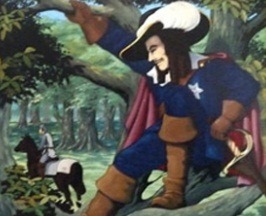thestuartkings: Oak Apple Day Oak Apple Day or Royal Oak Day was a holiday celebrated in England on
thestuartkings: Oak Apple Day Oak Apple Day or Royal Oak Day was a holiday celebrated in England on 29 May to commemorate the restoration of the English monarchy, in May 1660. In some parts of the country, the day was also known as Shick Shack Day, Oak and Nettle Day or Arbor Tree Day. In 1660, Parliament declared 29 May a public holiday: “Resolved, That a Bill be prepared for keeping of a perpetual Anniversary, for a Day of Thanksgiving to God, for the great Blessing and Mercy he hath been graciously pleased to vouchsafe to the People of these Kingdoms, after their manifold and grievous Sufferings, in the Restoration of his Majesty, with Safety, to his People and Kingdoms: And that the Nine-and-twentieth Day of May, in every Year, being the Birth Day of his Sacred Majesty, and the Day of his Majesty’s Return to his Parliament, be yearly set apart for that Purpose…” , -Journal of the House of Commons: volume 8: 1660-1667 The public holiday, Oak Apple Day, was formally abolished in 1859, but the date retains some significance in local or institutional customs. It is, for example, kept as Founder’s Day in the Royal Hospital Chelsea (founded by Charles II in 1681). During the course of the day the statue of Charles II in Figure Court is partly shrouded in oak leaves, and all participants in the Parade and spectators wear sprigs of oak leaves to commemorate the King’s escape from forces after the Battle of Worcester in 1651. The statue was re-gilded in 2002 to commemorate the Golden Jubilee of Queen Elizabeth II. Traditional celebrations to commemorate the Oak Apple Day often entailed the wearing of oak apples (a type of plant gall, possibly known in some parts of the country as a shick-shack) or sprigs of oak leaves, in reference to the occasion after the Battle of Worcester in September 1651, when the future Charles II of England escaped the Roundhead army by hiding in an oak tree near Boscobel House. Anyone who failed to wear a sprig of oak risked being pelted with bird’s eggs or thrashed with nettles. These ceremonies, which have now largely died out, are perhaps continuations of pre-Christian nature worship. The Garland King who rides through the streets of Castleton, Derbyshire, at the head of a procession, completely disguised in a garland of flowers, which is later affixed to a pinnacle on the parish church tower, can have little connection with the Restoration, even though he dresses in Stuart costume. He is perhaps a kind of Jack in the Green and the custom may have transferred from May Day when such celebrations were permitted again after having been banned by the Puritans. Events still take place at Upton-upon-Severn, Northampton, Aston on Clun in Shropshire, Marsh Gibbon in Buckinghamshire, Great Wishford in Wiltshire when villagers gather wood in Grovely Wood, and Membury in Devon. The day is generally marked by re-enactment activities at Moseley Old Hall, one of the houses where Charles II hid in 1651. At some Oxford and Cambridge halls a toast is still drunk to celebrate Oak Apple Day. -- source link
#charles ii#stuarts#17th century#history




